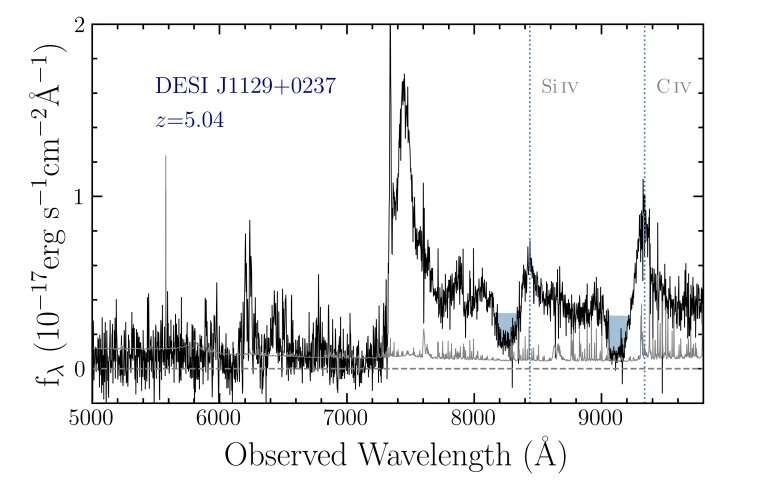February 13, 2023 report
This article has been reviewed according to Science X's editorial process and policies. Editors have highlighted the following attributes while ensuring the content's credibility:
fact-checked
preprint
trusted source
proofread
Hundreds of new high-redshift quasars discovered

An international team of astronomers reports the detection of more than 400 new high-redshift quasars using the Dark Energy Spectroscopic Instrument (DESI). The discovery, published February 3 on the arXiv preprint server, greatly improves the number of known distant quasars and demonstrates the capability of DESI to identify more objects of this type in the future.
Quasars, or quasi-stellar objects (QSOs), are extremely luminous active galactic nuclei (AGN) containing supermassive central black holes with accretion disks. Their redshifts are measured from the strong spectral lines that dominate their visible and ultraviolet spectra.
Astronomers are especially interested in finding new high-redshift quasars (at redshift higher than 4.4) as they are the most luminous and most distant compact objects in the observable universe. Spectra of such QSOs can be used to estimate the mass of supermassive black holes that constrain the evolution and formation models of quasars. Moreover, high-redshift QSOs that are also radio-bright are unique signposts of supermassive black hole activity in the early universe.
Now, a team of astronomers led by Jinyi Yang of the University of Arizona in Tucson, Arizona, has discovered 412 new quasars with redshifts between 4.44 and 6.53. The finding is based on the data from the DESI Legacy Imaging Surveys (the Legacy Surveys) DR9 photometry, combined with the Pan-STARRS1 data and J-band photometry from public surveys.
"In this paper, we report a DESI secondary program designed to search for quasars at z ∼ 5−6.5 using DESI," the researchers wrote/
Initially, the team identified 556 quasars, out of which 144 turned out to be known QSOs. Therefore, 412 quasars were detected for the first time and 25 of them were found at a very high redshift of more than 6.0. They noted that the newfound quasar, designated DESI J144355+350055 at a redshift of 6.53 is the highest-redshift new QSO identified from their survey to date.
The total number of known quasars at redshifts between 4.8 and 6.8 from previous studies is about 810. Thus, Yang's team underlined that their discovery (377 quasars with redshifts over 4.8) expanded the existing known quasar sample by about 46%.
The researchers noted that when it comes to detecting new quasars, DESI observations so far result in an average success rate of 23 . Hence, assuming this success rate, the scientists expect to find about 1,000 new quasars from this survey.
The authors of the paper added that based on the DESI survey, they aim to construct a large high-redshift quasar sample for scientific analyses. They plan to present details of the full quasar sample and present selection criteria as well as selection function when the identification of the entire sample is complete. They also want to push the high-redshift quasar search to a fainter magnitude in the future DESI survey.
More information: Jinyi Yang et al, DESI z >~ 5 Quasar Survey. I. A First Sample of 400 New Quasars at z ~ 4.7-6.6, arXiv (2023). DOI: 10.48550/arxiv.2302.01777
Journal information: arXiv
© 2023 Science X Network




















